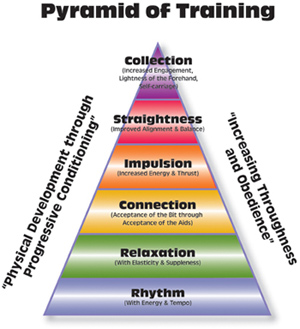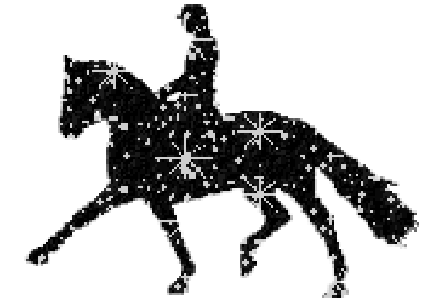The Yakima Valley Business Times recently published the following article that featured CWDS Member Megan Hays in their April 18, 2014 Issue. The article was written by Linda Prier and is reprinted here with permission of the Editor.
Not-so-easy Riders:
Lessons, Training Can Help Novices Handle a Horse
Horse trainers tend to have been raised on and around horses. They carry the knowledge learned when they were just babes on into their adult relationships with horses and with the people who ride them.
Members of the Hart family, owners of Hart Ranch in Selah, have all been in the saddle since they could walk.
Roger was raised in Mabton and Sue in Sunnyside; after they married, they raised 2,000 mother cows on a large ranch near Conconully for 20 years.
During that time, their young sons, Willy and John, were in the saddle much of the day. It was here that they, like their parents, learned the art of training horses. Twenty years ago, when Roger and Sue decided to move back closer to warmer winters and to where they were raised, they purchased their horse facility in Selah and focused entirely on horses, with a few cows on hand for roping.

The Hart family — from left, Willy, Sue and Roger — have spent their lives around horses. Hart Ranch offers horse training services plus boarding and riding lessons.
Hart Ranch specializes in training and boarding horses and giving riding lessons. The ranch is well set up to do so. The Harts have a huge indoor arena, over 40 indoor stalls and many outdoor spaces for boarding horses. They also sponsor a number of horse clinics, usually weekend events put on by renowned horse trainers.
Roger and Sue, both in their seventies now, still give riding lessons, but it is Willy who trains horses. And while he quit competing in team roping in the Pro Rodeo Circuit in 2009, that is going to change this year, now that the circuit finals will be held in Yakima.



All kinds of saddles, boots and other equine equipment abound at the Hart Ranch, which features an indoor riding arena, 40 indoor horse stalls and more space for boarding horses outside.
He has a large tack room full of saddles he has won over the years, and now those saddles are used for riders who come to Hart Ranch for lessons.
He said that as a child, his father taught the children by letting them ride with saddles, but without stirrups, which helped Willy and his brother learn balance. Another thing that really helped him was participating in FHA and in FFA in which English saddles were used.
“I learned to feel which lead my horse was on by using an English saddle,” he said.
The five most important things to teach a young horse are to “stop, stop, stop, stop and stop,” Willy said.
And along with teaching that important lesson, as a trainer, it is his job to inspire confidence in the horses he trains. “When a horse shows fear, it’s like taking your child to the haunted house. You have to be calm,” he said.
He said horses need to be taught by using small steps. “The art of getting on a young horse is not mashing on the gas pedal. You must imagine the reins as kite strings. You are very gentle, as you would be with a kite, and you are somewhat more aggressive with your legs,” he said.
He also said that it is often helpful to have someone on hand who is riding a veteran horse, for that horse’s presence creates an aura of calm.
He has trained several hundred horses; he tries to take new horses to different venues so they get used to scary new places. He specializes in colt breaking and colt starting and in team roping.
Hart charges $850 per month for training, and he provides full care. Lessons cost $40 per hour if people take their own horse or $60 per hour if they use one of the Harts’ school horses.
A Life in the Saddle
Like the Hart family, Megan Hays has been riding since she was a toddler. She said she has always been “horse crazy” and that she started riding Tuffy the pony when she was she was 4.
By the age of 9 she had graduated to Top Secret and was very active in the Yakima Pony Club, where she learned horse management and care, dressage and jumping. By the age of 17, she had progressed to a C3 rating and was clearing jumps that were over 3 feet.
She said that she has always really loved dressage and after pony club, she took lessons in Olympia, with famed dressage trainer and dressage judge Mike Osinski. After working with him, she won (with the help of her horse Satin) the US Dressage Federation’s Silver Medal.

Hays said that dressage is a “ballet between horse and rider, where the rider communicates with the horse in a way that emphasizes harmony and grace.”

Hays and her horses continue to compete. For them, competition this year begins at the end of April in Boring, Ore., and ends in September in Nampa, Idaho. Hays said that this year, she and her horse, Ca Zare’s Darjeeling (an Anglo Arab) are trying for gold.

Megan Hays starting riding horses as a toddler. She specializes in dressage riding and started offering training last year. She also competes in dressage events around the country.
She started training horses professionally last year. She is in the midst of building an outdoor arena, which will be ready for use at the end of spring, but for now, she primarily goes to people’s homes to train their horses.
She currently has 15 students who range in age from 15 to 60. Some of her students are beginners, but most choose Hays as a teacher because they want to learn dressage or to learn basic dressage.
When asked what her biggest challenge as a trainer is, she said, “There’s a tendency for people to over-horse themselves.” By this she means that people tend to buy horses that they may not be comfortable riding or handling.
“It is my job to teach students to become more comfortable with their horses, or to help them find a horse that is the right fit,” Hays said.
Another challenge is taking in a horse, training it, and then returning it to an owner who doesn’t know how to ask the horse to do the skills it has learned. Hays said that to make sure that the owners progress at the same rate as the horse in training, she asks the owners to have a weekly lesson on the horse while it’s being trained (once the horse is safe to ride) so that horse and owner skills are in sync and improve together.
Hays is also a registered nurse and is on call at the Kittitas Hospital in Ellensburg, and she occasionally fills in at her parents veterinary practice in the West Valley.
She charges $575 per month for training and $45 per hour for riding lessons. She can be reached at 360-348-8519.
Teaching The Basics
Emily and Tristan Bettinger, owners of the Golden Nugget Ranch in Selah, have also been in the saddle since they were children. They were both active in 4H, and while Emily hails from Spokane and Tristan from the Washington Coast, they met up in Powell, Wyo., where they both attended North West College and graduated from a two-year equine riding and training program in 2008.
They started the Golden Nugget Ranch in 2012.

Emily Scherzinger works with a horse in the ring at Golden Nugget Ranch in Selah.
“We are an amateur- and youth-friendly barn. Our training program is designed to produce safe horses who enjoy being ridden,” Tristan said.
He said they primarily offer Western-style riding lessons and that kids make up 80 percent of their clientele.
He said that their barn is set up to train six horses right now, but that most of their business involves teaching young riders the basics. “Getting the kids to the point where they are in charge of the horse is very gratifying.”

Tristan and Emily Scherzinger of Selah’s Golden Nugget Ranch, work mainly with young and inexperienced riders trying to learn the basics of horse management. Here Tristan puts a horse through its paces.
What’s the hardest part of being a trainer?
“Most trainers develop a technique and get comfortable with that technique. But horses, like people, are individuals, and you have to adapt your training methods to match individual horses,” he said.
But he added that good trainers know how to adapt and most are naturally adaptive.
And like the other trainers, Bettinger stressed that green riders should not be paired with green horses and that when he trains a horse for someone, lessons for the rider are included as well.
The Bettingers have a large, outdoor arena and charge $40 per lesson for riders who take their own horse or $35 per lesson for two people who supply their own horses. Their phone number is 509-481-1196.



 Photo by Susan J Stickle of Tom Noone on horse, Fred Astair, demonstrating lowering the haunches.
Photo by Susan J Stickle of Tom Noone on horse, Fred Astair, demonstrating lowering the haunches.

































































 I love my early morning coffee and my computer! I set in the overstuffed chair and read favorite blogs and search for new ones that appeal to my horsey interests. Sometimes these searches are due to a “challenge” I may be experiencing, or a comment someone made as we discuss a lesson or technique. Recently I’ve become interested in the process of giving full my full attention to the horse, becoming so in-tuned with the horse that I leave all other issues and stress at the gate, some call it developing a “feel”. So I was quite pleased when I happened upon Elizabeth Hanson’s newsletters for her Equestrian Pilates. In this article she shares four skills used to maximize the riding experience and become a team member with your horse. The insight provided is just what I needed. Perhaps you too will enjoy her writings and read more of her work at her site
I love my early morning coffee and my computer! I set in the overstuffed chair and read favorite blogs and search for new ones that appeal to my horsey interests. Sometimes these searches are due to a “challenge” I may be experiencing, or a comment someone made as we discuss a lesson or technique. Recently I’ve become interested in the process of giving full my full attention to the horse, becoming so in-tuned with the horse that I leave all other issues and stress at the gate, some call it developing a “feel”. So I was quite pleased when I happened upon Elizabeth Hanson’s newsletters for her Equestrian Pilates. In this article she shares four skills used to maximize the riding experience and become a team member with your horse. The insight provided is just what I needed. Perhaps you too will enjoy her writings and read more of her work at her site 
